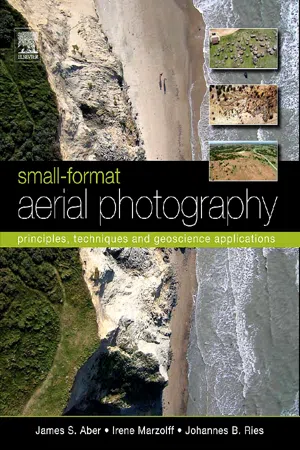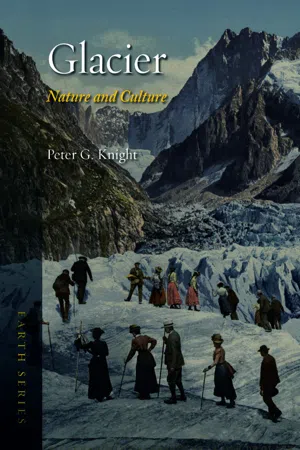Glacial Environment
A glacial environment refers to a landscape shaped by the movement and melting of glaciers. It is characterized by features such as U-shaped valleys, moraines, and cirques, as well as the presence of glacial lakes and rivers. Glacial environments play a significant role in shaping the Earth's surface and influencing local climates.
4 Key excerpts on "Glacial Environment"
- eBook - ePub
Small-Format Aerial Photography
Principles, Techniques and Geoscience Applications
- James S. Aber, Irene Marzolff, Johannes Ries(Authors)
- 2010(Publication Date)
- Elsevier Science(Publisher)
...Chapter 12 Glacial Geomorphology 12.1. INTRODUCTION Modern glaciers and ice sheets cover approximately 10% of the world’s land area. Of this, most glacier ice is found in Antarctica and Greenland with all other areas accounting for only about 5% of the total. During the Ice Age (Pleistocene Epoch) of the last one million years, glaciers and ice sheets expanded dramatically and repeatedly over large portions of northern Eurasian and North American lowlands and in mountains and high plateaus around the world. At times, the volume of glacier ice during the Pleistocene was at least triple that of today (Hughes et al., 1981). Global sea level declined by at least 120 m, which allowed ice sheets to spread over broad continental shelves, particularly north of Eurasia (Svendsen et al., 1999; Polyak et al., 2000). Geomorphology is the study of the Earth’s surficial landforms both on land and on the seafloor. This study is both descriptive and quantitative; it deals with morphology, processes, and origins of landforms. Glacier ice is a powerful agent that created many distinctive landforms that are well preserved nowadays in regions of former ice expansion. Glaciers modify the landscape in three fundamental ways by erosion, deposition, or deformation (Fig. 12-1). A given site may be subjected to each or all of these processes during the advance and retreat of a glacier, and repeated glaciation may overprint newer landforms on older ones. In addition, glacial meltwater is also an effective geomorphic agent that may erode or deposit conspicuous landforms in connection with glaciation. The results are complex landform assemblages that represent multiple glaciations during the Pleistocene. Aerial photography has long been utilized to illustrate, describe, interpret, and map the diverse types of landforms created by glaciation (e.g. Gravenor et al., 1960)...
- eBook - ePub
Glacier
Nature and Culture
- Peter G. Knight(Author)
- 2019(Publication Date)
- Reaktion Books(Publisher)
...From 1846, an engraving by John Emslie showing glaciers and perpetual snow as part of what we would now call the global climate system. 5 Glaciers and the Big Global System Glaciers are part of a complex, interconnected global environmental system. Their existence depends on a particular set of climatic conditions and is controlled by atmospheric circulation, the hydrological cycle, the positions of the wandering continents, the heights of mountain ranges, the tilt of the Earth’s axis, the luminosity of the Sun and many other factors. Changes in any one of these will affect the occurrence, properties and behaviour of glaciers. And they are all changing, all the time. What makes glaciers advance and retreat? The most direct way in which glaciers reflect environmental change is their expansion and contraction at timescales ranging from days to millions of years. These fluctuations reflect the amount of ice being supplied to the glacier by processes of accumulation (such as snowfall) and the amount being lost by processes of ablation (such as melting). This ‘mass balance’ is largely related to climate. If more ice is supplied than is lost the glacier will grow, and vice versa. The edge of the glacier is the position where the supply of ice from up-glacier is finally extinguished by ablation as the ice moves forward. Even when there is no long-term change, many glacier margins oscillate backwards and forwards a little every year in response to seasonal changes in ablation close to the margin. During summer, melting outweighs the forward movement of the ice and the margin retreats. During winter, ablation is low and the forward movement of ice exceeds the rate of ablation, so the margin advances. Over longer periods, changes in ablation and accumulation can be reflected in more substantial episodes of advance or retreat...
- eBook - ePub
- David N. Thomas, David N. Thomas(Authors)
- 2020(Publication Date)
- Wiley-Blackwell(Publisher)
...6 Ecology of Arctic Glaciers Alexandre M. Anesio 1 and Johanna Laybourn-Parry 2 1 Department of Environmental Science, Aarhus University, DK-4000, Roskilde, Denmark 2 School of Geographical Sciences, University of Bristol, BS8 1SS, Bristol, UK 6.1 Introduction The Glacial Environment provides a range of aquatic habitats that support biological activity. Broadly these can be categorized as the surface environments which change both in time and space from clean snow to different shades of green and red due to the presence of so-called snow algae and to bare ice with the presence of varied quantities of organic and inorganic particles and so-called ice algae (Stibal et al. 2012a ; Lutz et al. 2014) (Figure 6.1). At the end of the spectrum from clean snow to dirty ice are cryoconite holes, which are relatively small holes or mini-lakes on the ice surface filled with dark-colored inorganic and organic particles (known as cryoconite) and water from ice melt (Fountain et al. 2008 ; Hodson et al. 2008) (Figure 6.2). Other surface environments that are less well researched include cryolakes or supraglacial lakes on glaciers surfaces and ice sheets, as well as lakes on ice shelves that overlie the sea (Figure 6.3). These environments support communities of prokaryote and eukaryote microorganisms and some micro-Metazoa such as rotifers, nematodes, and tardigrades (Hodson et al. 2008 ; Anesio and Laybourn-Parry 2012 ; Zawierucha et al. 2016). Viruses are also considered to play an important role in supraGlacial Environments by promoting the release of dissolved nutrients from cells (Bellas et al. 2013) and/or transfer the genetic elements between bacterial cells (Anesio and Bellas 2011). Beneath glaciers and ice sheets subGlacial Environments that are dark and often oxygen depleted are found supporting prokaryote communities adapted to a range of redox conditions (Doyle et al. 2013)...
- eBook - ePub
Applied Climatology
Principles and Practice
- Allen Perry, Dr Russell Thompson, Russell Thompson(Authors)
- 2013(Publication Date)
- Routledge(Publisher)
...Likewise, water resources become critical under extreme climate conditions, especially when supply and demand lose their synchronization under drought episodes. Frozen water bodies (i.e. glaciers) are the true ‘progeny’ of climate which controls all their physical and thermal characteristics. For example, the conversion of snow to glacial ice and the mass balance of glaciers are critically related to climatic conditions (especially atmospheric heat transfers). The influence of climate on geomorphic processes and landforms is not so convincing since, at scales finer than the global or regional, generalizations about the role of climatic inputs in landform evolution have proved more difficult to sustain. The response of a landform to climate is known as landscape sensitivity and lowsensitivity landforms retain their characteristic forms mainly in response to local features and actual morphology, for example the supply of debris to rock glaciers. Over the past century, the above-ground climate has been accepted as one of the main environmental factors involved in soil formation. Soils and climate are indeed intimately interrelated and they bring together two of the most critical environmental parameters of life on the earth. The most important climatic elements are solar radiation, soil temperatures (which control chemical reactions and biological activity) and the soil moisture budget. However, it is evident from present-day soil classifications that there are important deviations in the relationship between soil patterns and climate data, since climate is only one of some five factors responsible for soil formation (Jenny, 1941). Also, soil zonations, based on present-day climate, do not necessarily reflect the conditions under which soils were originally formed, which could have been so different in the past...



